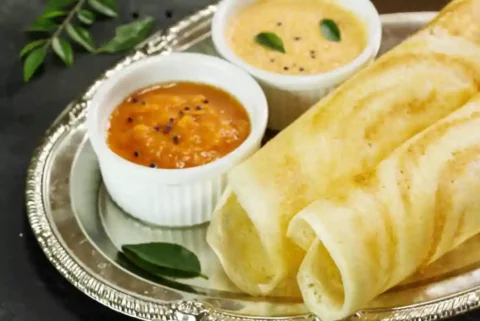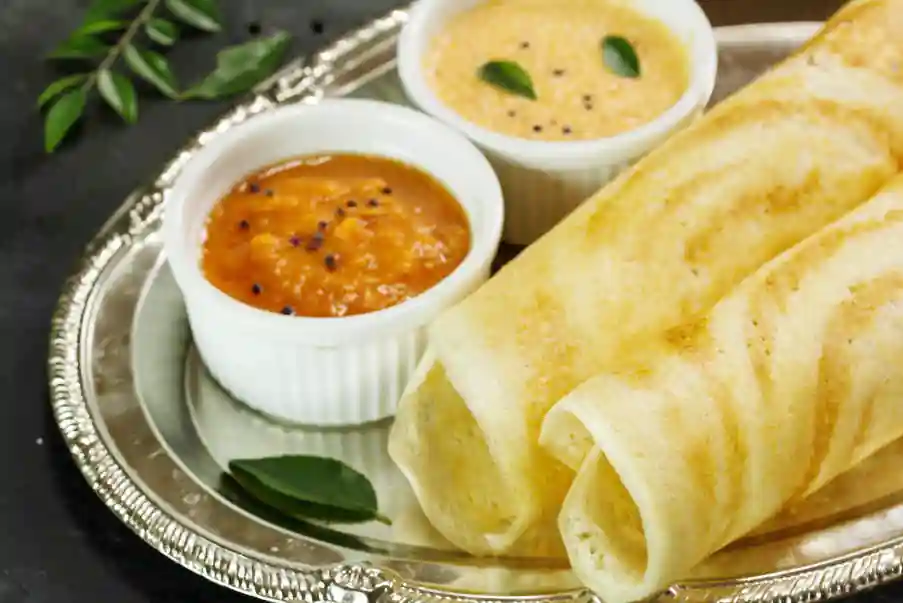When in London the first thing we do is plan an outing to Sagar, our favourite south Indian eatery, for our fix of the that crispy, light and savoury Indian delight: the Dosa
A flat, crisp pancake resembling a crepe, traditional dosa combines rice with washed black lentils in a batter which is then lacto-fermented to make the resultant pancake not just more digestible, but also bursting with health promoting friendly bacteria
Dosa are traditional to South Indian and Sri Lankan Tamil cuisines but are popular all over India – and beyond. They are a staple in South Indian restaurants in the West. Plain or filled they’re served with coconut chutney and sambar, a hot and sour South Indian vegetable dish flavoured with tamarind and curry leaves.
Dosa are made from a variety of grains and pulses, often fermented as in our urid dal – rice recipe below, sometimes not as in rava dosa made from cream of wheat. There are chickpea flour (besan) dosa, mung bean dosa, red lentil dosa … the list could be endless
We’ll explore some of these later. Now, we start with the basic recipe for rice and washed black lentil (urid dal) dosa
Key Ingredients For The Perfect Dosa Batter
Dosa can be made with a great variety of pulses and grain, sometimes singly, often in combination. The classic white dosa uses a mixture of rice and lentils as follows
1. Rice: Though parboiled and idli rice are widelt recommended for dosa, I can’t get away from Basmati being – well, the best rice in the world. Experimenting aside, why compromise?
2. Urad Dal: Also known as black gram, urad is an essential ingredient. Dosa batter is made from wahsed urad dal which, far being black, is actually creamy white. The lentil makes for a creamy texture and helps with fermentation.
3. Fenugreek Seeds: Adding a pinch of fenugreek of whole or ground seed to your dosa batter will enhance the flavor, and reputedly also aids in the fermentation process. I haven’t checked the science, but I definitely include it for the taste
4. The fourth ingredient, lactic acid is produced naturally as you rest your batter in a warm place to soak up the fifth ingredient …
5. Your friendly lacto-bacilli (bacteria) from the air
Preparing The Dosa Batter
1. Soaking the rice and lentils: Rinse the rice and lentils thoroughly and soak them in plenty of water in separate bowls for at least 4 hours, and preferably overnight. Soaking helps in softening the grains and initiates the fermentation process.
2. Grinding the batter: Once the rice and lentils are soaked, drain the water and transfer them to a blender. Add a pinch of fenugreek if you like, plus the least amount of water to be able to grind the mixture until it forms a smooth, thick, creamy batter.
3. Fermentation: Transfer the batter to a large bowl and cover it with a clean cloth or lid. Allow the batter to ferment for 8-12 hours or overnight, depending on the weather conditions. Fermentation is a crucial step as it helps in developing the characteristic tangy flavor of dosas and makes them light and fluffy
4. Seasoning the batter: Once the batter has fermented, add salt to taste and mix well. The batter is now ready to be used for making dosas. You can store the leftover batter in the refrigerator for up to 2-3 days.
Tips for Fermenting the Dosa Batter
Fermentation plays a vital role in the taste and texture of dosas. Here are some tips to ensure successful fermentation:
1. Temperature control: The ideal temperature for fermenting dosa batter is around 80-90°F (27-32°C). If the weather is cold, you may be forced to keep one room nice and toasty for the sake of the fermentation process. Here in Spain, bread and other ferments are placed “a flor de fuego”: by the fire’s bloom. Simply light a good fire and be careful not to place your batter too near it!
2. Consistency of the batter: The batter should be slightly thick and not too watery. A thick batter will aid in the fermentation process and result in soft and fluffy dosas.
3. Additives for fermentation: Fenugreek seeds (methi) are traditionally added to the soaked rice and lentils before grinding. Fenugreek seeds appear to act as a natural fermenting agent and help in achieving a good rise. As I said, I haven’t troubled to check the science, as I add fenugreek purely because I like the slightly bitter taste

- 1 tea-cup urid dal (washed balck lentil)
- 2 tea-cups basmati rice
- 1 tbsp oil
- 1 pinch salt (optional)
- rinse the rice and lentils and leave to soak in seperate bowls for 8 hours or overnight
- the following day add the rice and lentils to an electric blender in batches with enough water to create a batter the consistency of thick cream
- stir in the oil, cover and leave in the sun or a warm place all day until the batter has fermented and smells yeasty
- add a drop of oil to the skillet and coat the entire surface using some paper towel. Now heat the skillet to smoking point until most of the oil has burnt off. Allow the skillet to cool: drop a bit water onto the skillet or run the back of the skillet under a cold tap untill it stops sizzling
- re-warm the skillet until a drop of water just starts to sizzle. If the pan is too hot you won't be able to spread your dosa
- drop a large spoonfull of batter onto your skillet, then with the back of the spoon spread the batter from the middle outward in a circular, spiralling motion
- turn the heat up a little and wait for a golden brown colour to start showing throught to the upper uncooked side. The dosa should now come easily away from the skillet with the help of a spatula. If it doesn't leave it to cook a little longer
- Dosa are cooked on one side only: remove from the skillet, fold in half and serve it to your guests right away with some coconut chutney
- Place the back of the skillet under a cold tap to cool before making your next dosa
- Drop spoonfuls of batter onto a warm skillet and allow it to spread naturally. Bubbles will form on top giving the dosa a spongy appearance
- These dosa are smaller than the above and you can make several at a time if you have a large enough pan
- The dosa is cooked when no more bubbles appear, the top has fully solidified and the base is golden and comes away from the skillet easily
- Serve as above
Notes
It's likely that in the cooking process some of the fermentation products will be denatured, but the fermentation will help your gut better assimilate the rice and lentils and the taste will be absolutely great
Subscribe To Posts


I love dosa. I’ll try the soft fluffy variety and let you know how i get on. I might need help!